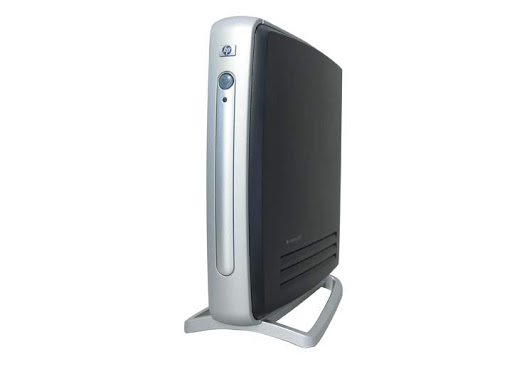HP Compaq T5000 - home seedbox

I want to introduce one old, but entertaining device, the HP Compaq T5000 thin client, to the habro-community.
Under cat description, photos and installation of rtorrent + rutorrent on it.
HP Compaq t5000 is a thin client, in my case, released in 2003. Thin client stuffing:
| processor | Transmeta (tm) Crusoe (tm) Processor TM5800 - 1000 MHz |
| memory | 128KiB L1 cache |
| memory | 512KiB L2 cache |
| memory | 256MiB SODIMM DDR |
| bridge | VT8231 [PCI-to-ISA Bridge] |
| bridge | VT8235 ACPI |
| storage | VT82C586A / B / VT82C686 / A / B / VT823x / A / C PIPC Bus Master IDE |
| disk | 256MB 256MB ATA Flash |
| bus | VT82xxxxx UHCI USB 1.1 Controller |
| multimedia | VT82C686 AC97 Audio Controller |
| network | VT6102 [Rhine-II] |
In my case, Windows XP embedded on one and Windows CE .NET on the other was installed on the thin client. Which operating system is installed depends only on the size of RAM and the IDE DOM module.
The first thing that came to mind was to turn on RDP (remote control), install uTorrent, connect a USB hard drive and use it all as a torrent download. Fortunately, the thin client consumes within 20W.
After a little thought, I decided to install Ubuntu. because There was no CD drive at hand, but the tftp server was raised, it was decided to install Ubuntu over the network. And since the 256MB built-in IDE DOM is clearly not enough, I put the system on a 4 gig USB flash drive. The installation option that suits me is described here
simplistically, I just took the ubuntu-installer folder from netboot.tar.gz, put it in / tftpboot / and in /tftpboot/pxelinux.cfg/01-00-0b-cd-6d-8e-58 added: 01-00-0b-cd-6d-8e-58 is the mac address of the thin client.
include ubuntu-installer/i386/boot-screens/menu.cfg
default ubuntu-installer/i386/boot-screens/vesamenu.c32
prompt 0
timeout 0
Next, the installation process rtorrent + rutorrent.
apt-get install rtorrent wget libapache2-mod-scgi apache2 php5 php5-mysql php5-curl screen
wget rutorrent.googlecode.com/files/rtorrent-2.8.tar.gz
tar zxf rtorrent-2.8.tar.gz
mv rtorrent /var/www/
echo 'SCGIMount /RPC2 127.0.0.1:5000' >> /etc/apache2/apache2.conf
ln -s /etc/apache2/mods-available/scgi.load /etc/apache2/mods-enabled/
service apache2 restart
useradd torrent -d /torrents/
echo 'scgi_port = localhost:5000' > /torrents/.rtorrent.rc
echo 'port_range = 6925-6925' >> /torrents/.rtorrent.rc
echo 'schedule = watch_directory,5,5,load_start=/torrents/watch/*.torrent' >> /torrents/.rtorrent.rc
echo 'directory = /torrents/download/' >> /torrents/.rtorrent.rc
echo 'session = /torrents/session/' >> /torrents/.rtorrent.rc
echo 'hash_read_ahead = 32' >> /torrents/.rtorrent.rc
echo 'hash_max_tries = 1' >> /torrents/.rtorrent.rc
echo 'hash_interval = 1' >> /torrents/.rtorrent.rc
mkdir -p /torrents/{download,session,watch}
chown -R torrent:torrent /torrents/
wget libtorrent.rakshasa.no/attachment/wiki/RTorrentCommonTasks/rtorrentInit.sh?format=raw -O /etc/init.d/rtorrent
sed -i 's/user="user"/user="torrent"/' /etc/init.d/rtorrent
chmod +x /etc/init.d/rtorrent
update-rc.d rtorrent defaults
/etc/init.d/rtorrent start
Now let's move on to the hardware (pictures are clickable).
 |  |  |  |  |  |
 |  |  |  |  |  |
If you spit on aesthetics, you can remove the cover and insert the SATA controller, to which you connect ordinary hard drives.
